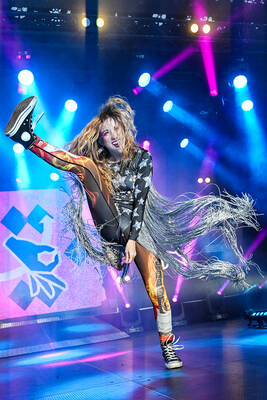Cheng Wei-hao’s (程偉豪) debut feature, The Tag-Along (紅衣小女孩), contain an element that will terrify movie-goers in a way that foreign horror flicks can’t: a familiarity with Taiwanese folklore. The ghost in this smartly-written film comes from a famous home video broadcast on television in 1988. Shot by a group of climbers, the video shows a little girl in a red dress following them on a mountain trail. No one in the team knew or saw the girl, but she is believed to be Moxina (魔神仔), a kind of mountain demon known to steal humans — usually children and the elderly.
The first half of the film centers on Wei (River Huang, 黃河), a real estate broker who was raised by and lives with his grandmother (Liu Yin–shang, 劉引商). Their sleepy neighborhood is roused one day by the disappearance of an old man. Wei doesn’t pay much attention to the missing-person case, nor does he have time for his grandmother. Wei has his own worries.
Like many Taiwanese, Wei works long hours, but feels he can’t afford to start a family. His girlfriend Yi-chun (Tiffany Ann Hsu, 許瑋甯) repeatedly turns down his marriage proposals, claiming that marriage and babies are not her thing.

Photo courtesy of Vievision Pictures
One night, Wei’s grandmother disappears. Creepy things begin to happen, including the appearance of a strange-looking girl in a red dress who is caught on a surveillance camera.
Then, Wei vanishes.
Distraught, Yi-chun suddenly realizes Wei’s importance in her life. Frightened residents begin to suspect that the mountain demon has appeared because humans have encroached on its mountain home.
With The Tag-Along, Cheng reveals his talent for storytelling, offering a new interpretation of the mountain demon story, effectively placing it in the genre of eco-horror cinema, where disastrous ecological consequences of human activity transform into an vengeful evil force.
The thrills are effectively crafted. The girl from the ghost video is brought back to life and roams the neighborhood in search of victims. Cheng creates a familiar, everyday setting where the specter lurks in a dark corridor or squats on top of a bookshelf.
The characters and their surroundings are never contrived. They seem to have the same worries as we do and face the same emotional struggles because their hectic, urban lifestyle leaves them exhausted. The suspense is mostly psychological, relying on characters’ fears, guilt and beliefs.
Huang looks as suitably weary as a man torn between family and work. The film’s narrative weight, however, is largely carried by Hsu’s character as a smart, independent woman who overcomes her fear of intimacy and regains the ability to love. The actress proves she has both the look and intellect to deliver a convincing performance.
The other actors has also been well cast. Acting veterans Liu and Chang Po-chou (張柏舟) make a rare onscreen appearance, showing how a solid supporting performance can take a film up a notch.
For those who haven’t seen the legendary ghost video, The Tag-Along does a good job of making sure that the original image is clearly restored.

The Taipei Times last week reported that the rising share of seniors in the population is reshaping the nation’s housing markets. According to data from the Ministry of the Interior, about 850,000 residences were occupied by elderly people in the first quarter, including 655,000 that housed only one resident. H&B Realty chief researcher Jessica Hsu (徐佳馨), quoted in the article, said that there is rising demand for elderly-friendly housing, including units with elevators, barrier-free layouts and proximity to healthcare services. Hsu and others cited in the article highlighted the changing family residential dynamics, as children no longer live with parents,

It is jarring how differently Taiwan’s politics is portrayed in the international press compared to the local Chinese-language press. Viewed from abroad, Taiwan is seen as a geopolitical hotspot, or “The Most Dangerous Place on Earth,” as the Economist once blazoned across their cover. Meanwhile, tasked with facing down those existential threats, Taiwan’s leaders are dying their hair pink. These include former president Tsai Ing-wen (蔡英文), Vice President Hsiao Bi-khim (蕭美琴) and Kaohsiung Mayor Chen Chi-mai (陳其邁), among others. They are demonstrating what big fans they are of South Korean K-pop sensations Blackpink ahead of their concerts this weekend in Kaohsiung.

Oct 20 to Oct 26 After a day of fighting, the Japanese Army’s Second Division was resting when a curious delegation of two Scotsmen and 19 Taiwanese approached their camp. It was Oct. 20, 1895, and the troops had reached Taiye Village (太爺庄) in today’s Hunei District (湖內), Kaohsiung, just 10km away from their final target of Tainan. Led by Presbyterian missionaries Thomas Barclay and Duncan Ferguson, the group informed the Japanese that resistance leader Liu Yung-fu (劉永福) had fled to China the previous night, leaving his Black Flag Army fighters behind and the city in chaos. On behalf of the

I was 10 when I read an article in the local paper about the Air Guitar World Championships, which take place every year in my home town of Oulu, Finland. My parents had helped out at the very first contest back in 1996 — my mum gave out fliers, my dad sorted the music. Since then, national championships have been held all across the world, with the winners assembling in Oulu every summer. At the time, I asked my parents if I could compete. At first they were hesitant; the event was in a bar, and there would be a lot